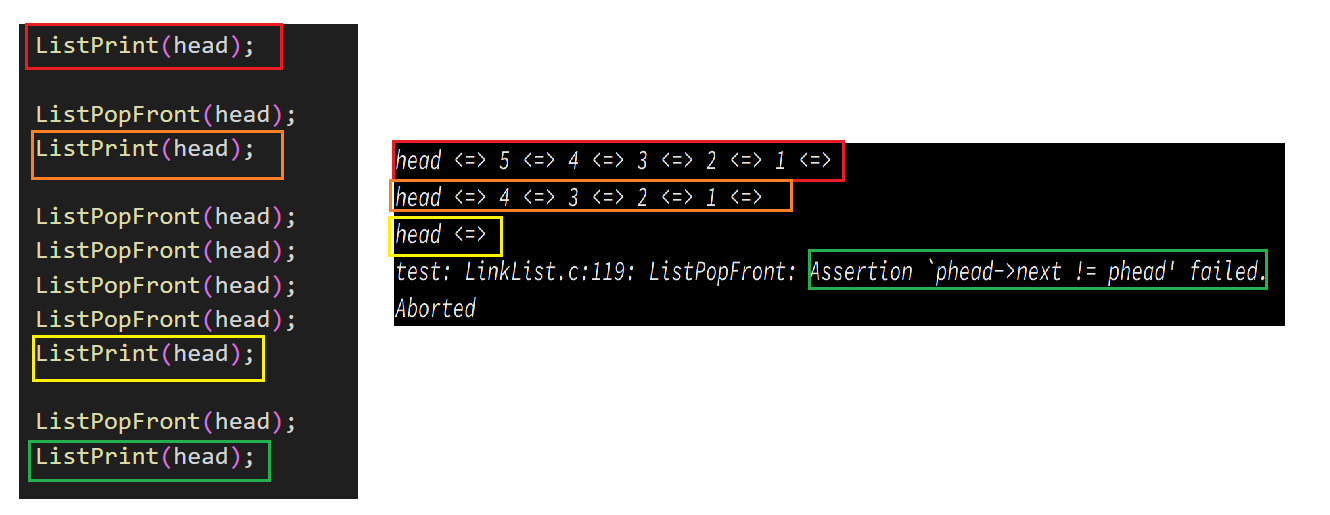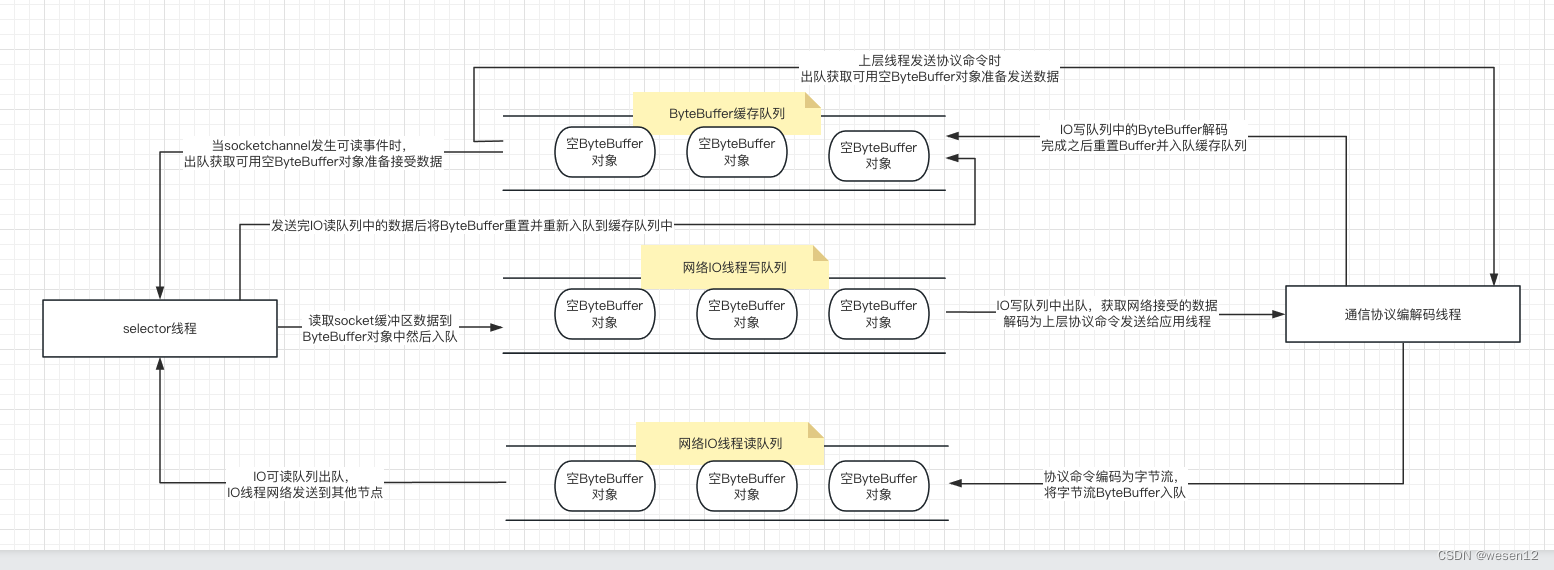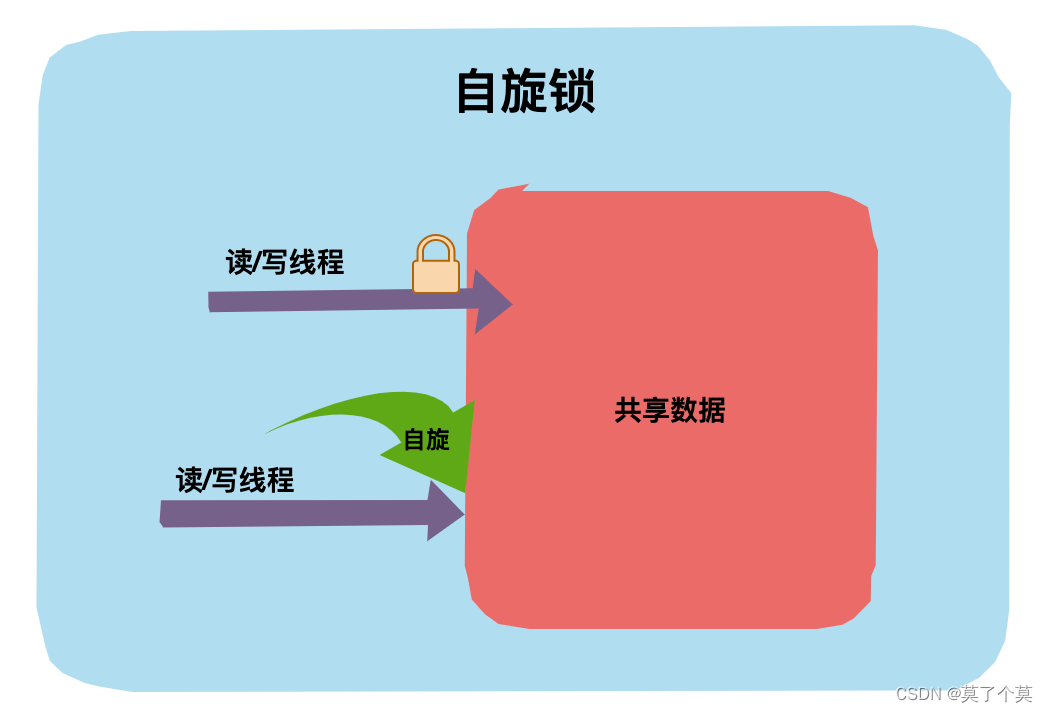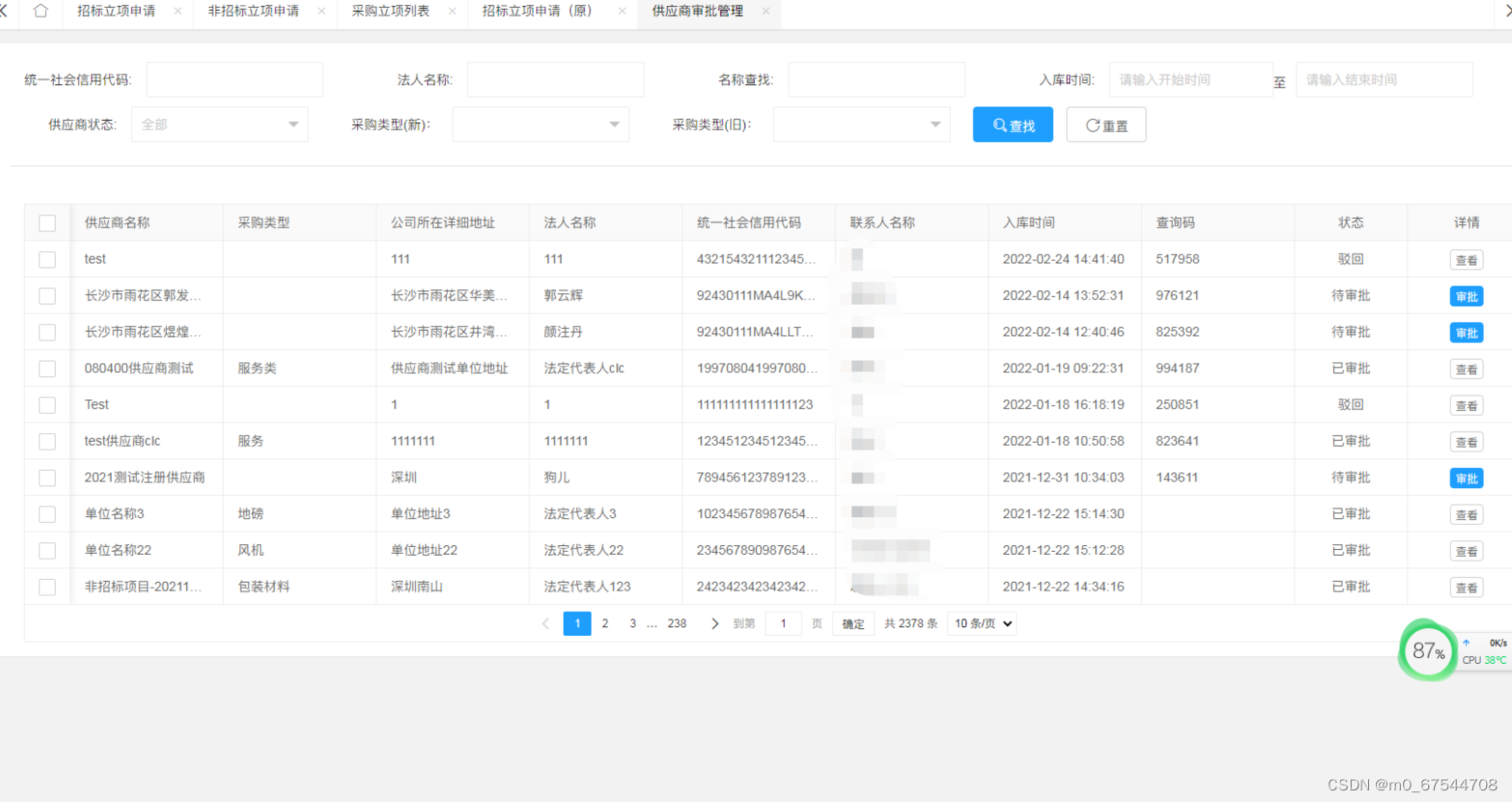之前一章学习了单链表的相关操作, 但是单链表的限制却很多, 比如不能倒序扫描链表, 解决方法是在数据结构上附加一个域, 使它包含指向前一个单元的指针即可.
那么怎么定义数据结构呢? 首先我们先了解以下链表的分类
1. 链表的分类
链表的结构非常多样, 以下情况组合起来就有 8 中链表结构
-
单向或者双向

-
带头或者不带头

-
循环或者非循环

虽然有这么多的链表的结构, 但是我们实际上最常用的还是两种结构:
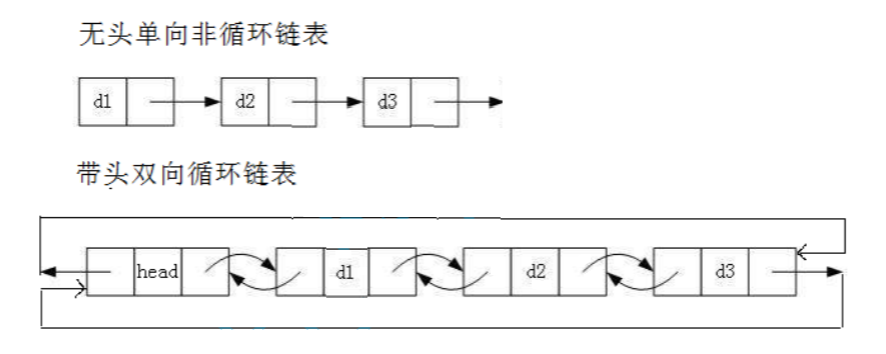
无头单向非循环链表
结构简单,一般不会单独用来存放数据.实际上更多是作为其他数据结构的子结构, 如哈希桶, 图的邻接表等等. 另外这种结构在笔试面试中出现很多
带头双向循环链表
结构最复杂, 一般用于单独存储数据.实际上使用的链表数据结构, 都是带头双向循环链表. 虽然结构复杂, 但是实现相关功能比较简单.
严格来说只用实现
Insert和Erase两个功能, 就可以实现 “二十分钟” 写完一个链表的任务.
2. 带头双向循环链表
2.1 带头双向循环链表的定义
typedef int LTDataType; //LTDataType = int
typedef struct ListNode
{LTDataType data; //数据域struct ListNode* prev; //指向前一个结点struct ListNode* next; //指向后一个结点
}ListNode; //重命名为 ListNode
- 相比较单链表的数据结构, 只需要多一个域用来指向前面一个结点就可以了.
- 这里使用
ListNode来命名这个数据结构, 方便后续学习 STL 进行知识迁移
2.2 接口函数
// 创建并返回链表的头结点
ListNode* ListCreate();
// 双向链表销毁
void ListDestroy(ListNode* phead);
// 双向链表打印
void ListPrint(ListNode* phead);
// 双向链表尾插
void ListPushBack(ListNode* phead, LTDataType x);
// 双向链表尾删
void ListPopBack(ListNode* phead);
// 双向链表头插
void ListPushFront(ListNode* phead, LTDataType x);
// 双向链表头删
void ListPopFront(ListNode* phead);
// 双向链表查找
ListNode* ListFind(ListNode* phead, LTDataType x);
// 双向链表在 pos 的前面进行插入
void ListInsert(ListNode* pos, LTDataType x);
// 双向链表删除 pos 位置的结点
void ListErase(ListNode* pos);
3. 接口函数的实现
因为有虚拟结点的存在, 所以除了创建头结点的函数, 其余接口函数都不会修改结构体指针, 只是修改结构体.
为了统一接口形式, 统一使用一级指针作为函数的形参类型. 需要修改头结点的函数接口, 直接用返回值的方法达到修改头结点指针的目的.
3.1 创建并返回链表的头结点 (ListCreate)

创建链表即为创建头结点, 它是一个虚拟结点(dummy node), 实际的值没有意义.它的两个指针都指向自己.
ListList.h
#pragma once #include <stdio.h>
#include <stdlib.h>
#include <assert.h>typedef int LTDataType;
typedef struct ListNode
{LTDataType data; //数据域struct ListNode* prev; //指向前一个结点struct ListNode* next; //指向后一个结点
}ListNode;// 创建并返回链表的头结点
ListNode* ListCreate();
修改头结点指针, 使用返回值接受头结点的指针
ListList.c
// 创建返回链表的头结点
ListNode* ListCreate()
{// 动态开辟空间创建头结点, 如果开辟失败直接结束程序ListNode* head = BuyListNode(0);// 处理链表数据, 数据域随机值, 两个指针指向自己head->next = head;head->prev = head;return head;
}
- 这里的
BuyListNode()是一个我自己定义的静态函数, 方便后续复用. 函数的功能是用来从堆中申请空间用来创建一个新结点.// 创建一个新结点 static ListNode* BuyListNode(LTDataType x) {ListNode* newNode = (ListNode*)malloc(sizeof(struct ListNode));if (newNode == NULL){perror("malloc fail");exit(-1);}newNode->data = x;newNode->next = NULL;newNode->prev = NULL;return newNode; }
- 创建头结点后, 使头结点指向自己
test.c
void LinkListTest1()
{ListNode* head = ListCreate();free(head);
}
测试调试结果如下:
头结点创建成功, 并且头结点两个指针都指向了自己
3.2 双向链表打印 (ListPrint)
从第一个结点开始遍历链表每个结点, 并且将结点的数据域打印出来, 直到遇到头结点结束
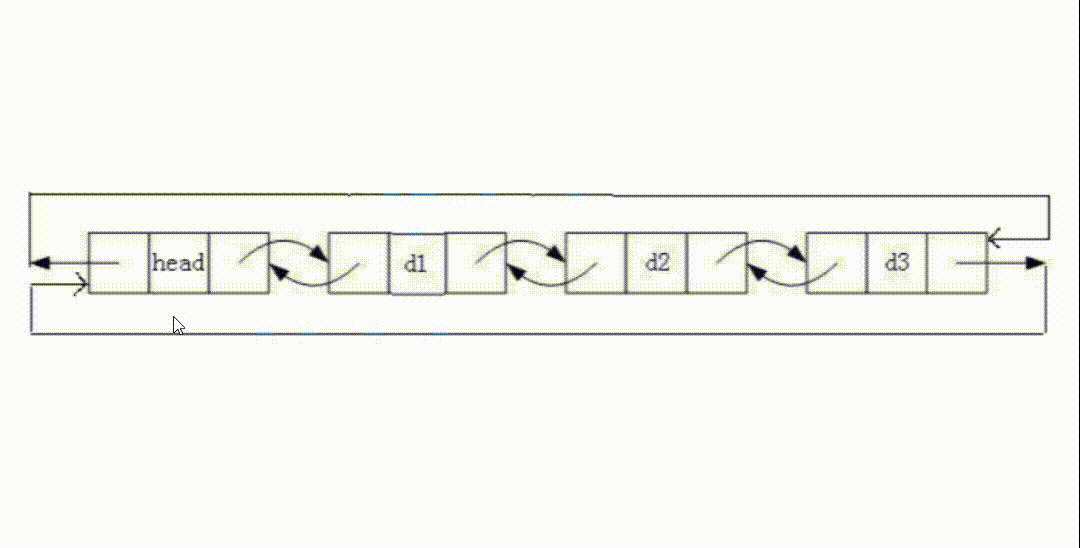
ListList.h
void ListPrint(ListNode* phead);
ListList.c
// 双向链表打印
void ListPrint(ListNode* phead)
{assert(phead); //确保头结点存在printf("head <=> ");ListNode* cur = phead->next; //从第一个结点开始遍历, 直到遇到头结点结束while (cur != phead){printf("%d <=> ", cur->data);cur = cur->next;}printf("\n");
}
- 确保头结点存在
cur第一次定位到头结点后面一个结点, 即第一个有效结点
- 顺序遍历并且打印
test.c
后续调试其他函数功能都会使用到
ListPrint函数, 这里就先不调试了.
3.3 双向链表尾插 (ListPushBack)
先找到链表尾结点的位置, 在尾结点和头结点之间插入一个新结点
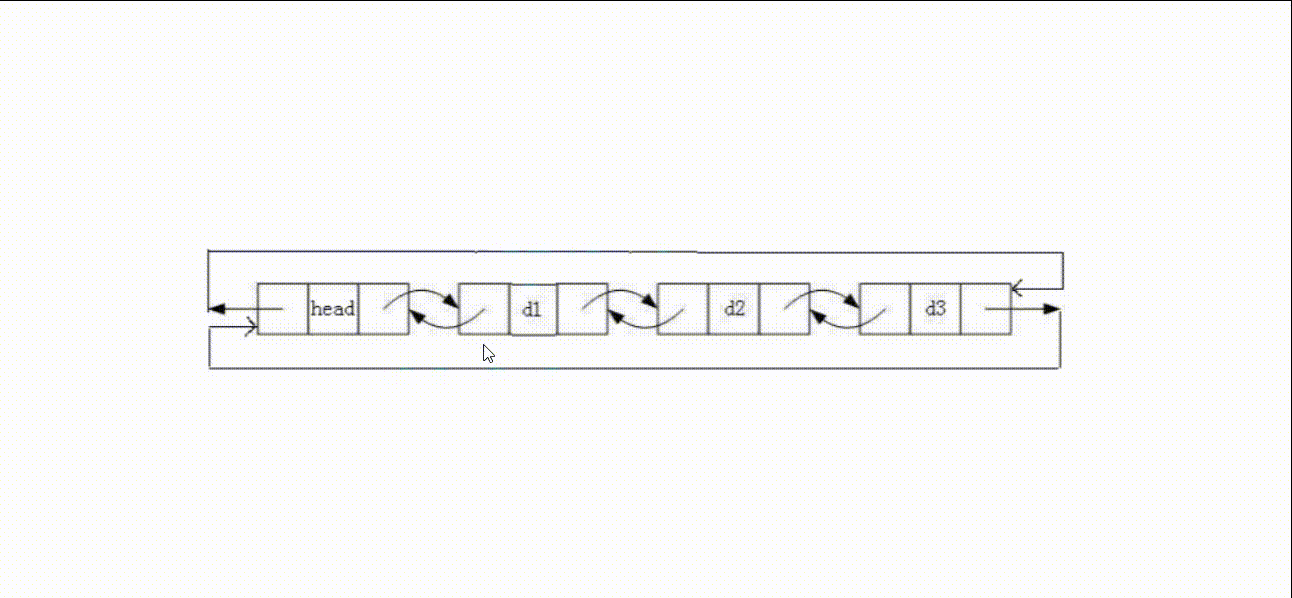
ListList.h
void ListPushBack(ListNode* phead, LTDataType x);
ListList.c
// 双向链表尾插
void ListPushBack(ListNode* phead, LTDataType x)
{assert(phead); //确保头结点存在ListNode* newNode = BuyListNode(x); //创建新结点 ListNode* tail = phead->prev; //找到尾结点//更改链接关系tail->next = newNode;newNode->prev = tail;phead->prev = newNode;newNode->next = phead;}
- 确保头结点存在
- 更改链接关系, 需要修改一共四根指针的指向关系
test.c
void LinkListTest1()
{ListNode* head = ListCreate();ListPushBack(head, 1);ListPushBack(head, 2);ListPushBack(head, 3);ListPushBack(head, 4);ListPushBack(head, 5);ListPrint(head);
}
测试结果如下:
3.4 双向链表尾删 (ListPopBack)
找到新的尾结点位置, 更改链接关系后将原尾结点删除
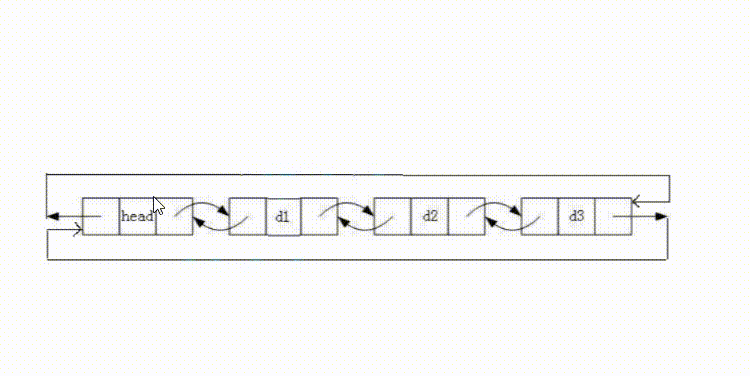
ListList.h
void ListPopBack(ListNode* phead);
ListList.c
// 双向链表尾删
void ListPopBack(ListNode* phead)
{assert(phead); //确保头结点存在assert(phead->next != phead); //确保有结点可删ListNode* tail = phead->prev; //找到要删除的尾结点ListNode* tailPrev = tail->prev; //找到新的尾结点//更改链接关系tailPrev->next = phead;phead->prev = tailPrev;free(tail); //释放空间
}
test.c
void LinkListTest1()
{ListNode* head = ListCreate();ListPushBack(head, 1);ListPushBack(head, 2);ListPushBack(head, 3);ListPushBack(head, 4);ListPushBack(head, 5);ListPrint(head);ListPopBack(head);ListPrint(head);ListPopBack(head);ListPrint(head);ListPopBack(head);ListPopBack(head);ListPopBack(head);ListPrint(head);ListPopBack(head);ListPrint(head);ListDestroy(head);
}
测试结果如下:
3.5 双链表头插 (ListPushFront)
找到原第一个有效节点, 在头结点和这个结点之间插入一个新结点
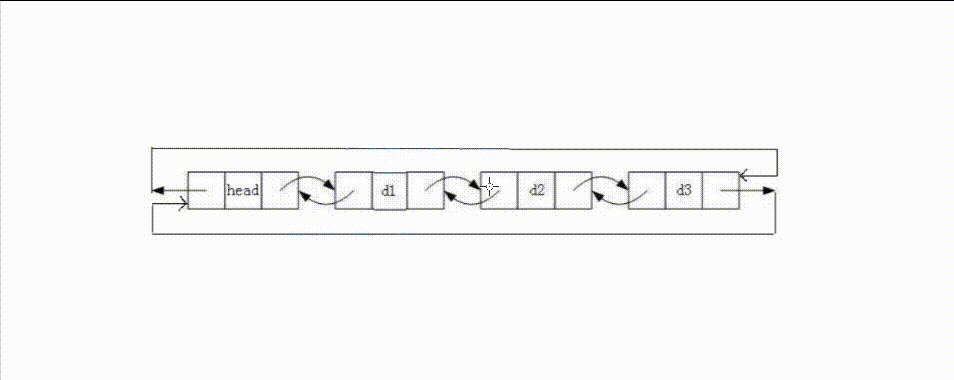
ListList.h
void ListPushFront(ListNode* phead, LTDataType x);
ListList.c
// 双向链表头插
void ListPushFront(ListNode* phead, LTDataType x)
{assert(phead); //确保头结点存在ListNode* newNode = BuyListNode(x); //创建新结点ListNode* first = phead->next; //找到原来的第一个结点//更新链接关系phead->next = newNode;newNode->prev = phead;newNode->next = first;first->prev = newNode;
}
- 确保头结点存在
- 在头结点和第一个有效结点之间插入新结点
test.c
void LinkListTest2()
{ListNode* head = ListCreate();ListPushFront(head, 1);ListPushFront(head, 2);ListPushFront(head, 3);ListPushFront(head, 4);ListPushFront(head, 5);
}
测试运行结果如下:
3.6 双链表头删 (ListPopFront)
先找到第一个和第二个有效结点, 更新头结点和第二个有效结点之间的链接关系后, 释放第一个结点的空间.

ListList.h
void ListPopFront(ListNode* phead);
ListList.c
// 双向链表头删
void ListPopFront(ListNode* phead)
{assert(phead); //确保哨兵结点存在assert(phead->next != phead); //确保链表不为空ListNode* first = phead->next; //找到头结点位置ListNode* second = first->next; //找到头结点后一个结点的位置//更新链接关系phead->next = second;second->prev = phead;free(first); //释放空间
}
test.c
void LinkListTest2()
{ListNode* head = ListCreate();ListPushFront(head, 1);ListPushFront(head, 2);ListPushFront(head, 3);ListPushFront(head, 4);ListPushFront(head, 5);ListPrint(head);ListPopFront(head);ListPrint(head);ListPopFront(head);ListPopFront(head);ListPopFront(head);ListPopFront(head);ListPrint(head);ListPopFront(head);ListPrint(head);ListDestroy(head);
}
测试结果如下:
3.7 双链表查找 (ListFind)
从第一个有效结点开始向后遍历链表, 判断是否有想要查找的数据, 直到遇到头结点. 未查找到返回空指针, 查找到返回该结点的地址
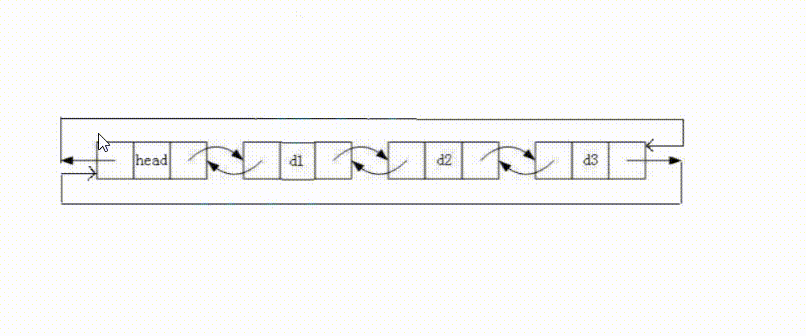
ListList.h
ListNode* ListFind(ListNode* phead, LTDataType x);
ListList.c
// 双向链表查找
ListNode* ListFind(ListNode* phead, LTDataType x)
{assert(phead); //确保哨兵结点存在ListNode* cur = phead->next;while (cur != phead){if (cur->data == x){return cur;}cur = cur->next;}return NULL;
}test.c
void LinkListTest3()
{ListNode* head = ListCreate();ListPushBack(head, 1);ListPushBack(head, 2);ListPushBack(head, 3);ListPushBack(head, 4);ListPushBack(head, 5);ListPrint(head);ListNode* pos;pos = ListFind(head, 2);printf("pos <=> ");while (pos && pos != head){printf("%d <=> ", pos->data);pos = pos->next;}puts("\n");pos = ListFind(head, 6);printf("pos <=> ");while (pos && pos != head){printf("%d <=> ", pos->data);pos = pos->next;}puts("\n");
}
测试运行结果如下:
3.8 双向链表在 pos 的前面进行插入 (LinkInsert)
先找到 pos 的前面一个结点的位置, 随后在这个结点和 pos 之间插入新结点
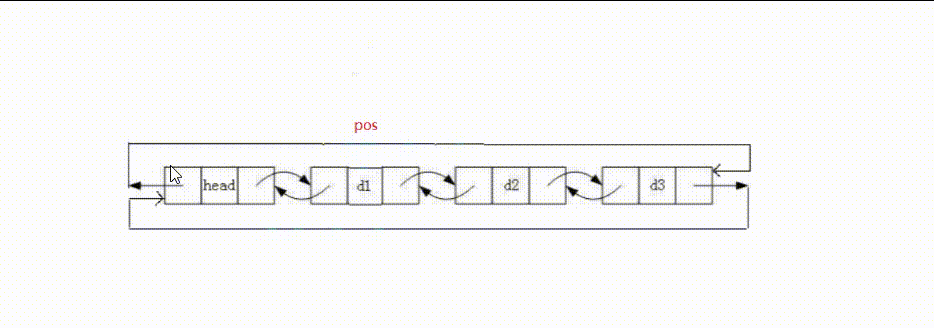
LinkList.h
void ListInsert(ListNode* pos, LTDataType x);
LinkList.c
// 双向链表在 pos 之前插入
void ListInsert(ListNode* pos, LTDataType x)
{assert(pos); //确保pos合法ListNode* newNode = BuyListNode(x); //创建新结点ListNode* posPrev = pos->prev; //找到 pos 前一个结点的位置//更新链接方式posPrev->next = newNode;newNode->prev = posPrev;newNode->next = pos;pos->prev = newNode;
}
test.c
void LinkListTest3()
{ListNode* head = ListCreate();ListPushBack(head, 1);ListPushBack(head, 2);ListPushBack(head, 3);ListPushBack(head, 4);ListPushBack(head, 5);ListPrint(head);ListNode* pos;pos = ListFind(head, 1);if (pos){ListInsert(pos, -1);ListPrint(head);}pos = ListFind(head, 4);if (pos){ListInsert(pos, -4);ListPrint(head);}pos = ListFind(head, 6);if (pos){ListInsert(pos, -6);ListPrint(head);}ListDestroy(head);
}
测试运行结果如下:
3.9 双向链表删除 pos 位置的结点 (ListErase)
先找到 pos 的前后两个结点的位置, 随后更新两个结点之间的链接关系, 最后删除 pos 结点
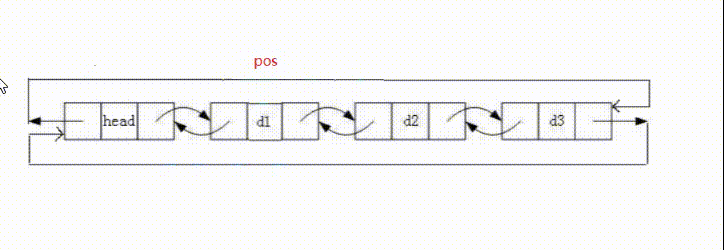
LinkList.h
void ListErase(ListNode* pos);
LinkList.c
// 双向链表删除 pos 位置的结点
void ListErase(ListNode* pos)
{assert(pos); //确保 pos 合法ListNode* posPrev = pos->prev; //找到 pos 前一个结点的位置ListNode* posNext = pos->next; //找到 pos 后一个结点的位置//更新链接方式posPrev->next = posNext;posNext->prev = posPrev;free(pos); //释放空间
}
test.c
void LinkListTest3()
{ListNode* head = ListCreate();ListPushBack(head, 1);ListPushBack(head, 2);ListPushBack(head, 3);ListPushBack(head, 4);ListPushBack(head, 5);ListPrint(head);ListNode* pos;pos = ListFind(head, 1);if (pos){ListErase(pos);ListPrint(head);}pos = ListFind(head, 4);if (pos){ListErase(pos);ListPrint(head);}pos = ListFind(head, 6);if (pos){ListErase(pos);ListPrint(head);}ListDestroy(head);
}
测试运行结果如下:
3.10 双向链表销毁 (ListDestroy)
LinkList.h
void ListDestroy(ListNode* phead);
LinkList.c
// 双向链表销毁
void ListDestroy(ListNode* phead)
{assert(phead); //确保哨兵结点存在ListNode* cur = phead->next;while (cur != phead){ListNode* nextNode = cur->next;free(cur);cur = nextNode;}free(phead);
}
4. 总结
| 不同点 | 顺序表 | 链表 |
|---|---|---|
| 存储空间上 | 物理上一定连续 | 逻辑上连续,但物理上不一定连续 |
| 随机访问 | 支持: O ( 1 ) O(1) O(1) | 不支持: O ( N ) O(N) O(N) |
| 任意位置插入或者删除元素 | 可能需要搬移元素, 效率低 O ( N ) O(N) O(N) | 只需要修改指针指向 |
| 插入 | 动态顺序表, 空间不够时, 需要扩容 | 没有容量的概念 |
| 应用场景 | 元素高效存储 + 频繁访问 | 任意位置插入和删除频繁 |
| 缓存利用率 | 高 | 低 |
5. 完整代码
LinkList.h
#pragma once #include <stdio.h>
#include <stdlib.h>
#include <assert.h>typedef int LTDataType;
typedef struct ListNode
{LTDataType data; //数据域struct ListNode* prev; //指向前一个结点struct ListNode* next; //指向后一个结点
}ListNode;// 创建并返回链表的头结点
ListNode* ListCreate();
// 双向链表销毁
void ListDestroy(ListNode* phead);
// 双向链表打印
void ListPrint(ListNode* phead);
// 双向链表尾插
void ListPushBack(ListNode* phead, LTDataType x);
// 双向链表尾删
void ListPopBack(ListNode* phead);
// 双向链表头插
void ListPushFront(ListNode* phead, LTDataType x);
// 双向链表头删
void ListPopFront(ListNode* phead);
// 双向链表查找
ListNode* ListFind(ListNode* phead, LTDataType x);
// 双向链表在 pos 的前面进行插入
void ListInsert(ListNode* pos, LTDataType x);
// 双向链表删除 pos 位置的结点
void ListErase(ListNode* pos);LinkList.c
#include "LinkList.h"// 创建一个新结点
static ListNode* BuyListNode(LTDataType x)
{ListNode* newNode = (ListNode*)malloc(sizeof(struct ListNode));if (newNode == NULL){perror("malloc fail");exit(-1);}newNode->data = x;newNode->next = NULL;newNode->prev = NULL;return newNode;
}// 创建返回链表的头结点
ListNode* ListCreate()
{// 动态开辟空间创建头结点, 如果开辟失败直接结束程序ListNode* head = BuyListNode(0);// 处理链表数据, 数据域随机值, 两个指针指向自己head->next = head;head->prev = head;return head;
}// 双向链表打印
void ListPrint(ListNode* phead)
{assert(phead); //确保哨兵结点存在printf("head <=> ");ListNode* cur = phead->next; //从头结点开始遍历, 直到遇到哨兵结点结束while (cur != phead){printf("%d <=> ", cur->data);cur = cur->next;}printf("\n");
}// 双向链表销毁
void ListDestroy(ListNode* phead)
{assert(phead); //确保哨兵结点存在ListNode* cur = phead->next;while (cur != phead){ListNode* nextNode = cur->next;free(cur);cur = nextNode;}free(phead);
}// 双向链表尾插
void ListPushBack(ListNode* phead, LTDataType x)
{assert(phead); //确保哨兵结点存在ListNode* newNode = BuyListNode(x); //创建新结点 ListNode* tail = phead->prev; //找到尾结点//更改链接关系tail->next = newNode;newNode->prev = tail;phead->prev = newNode;newNode->next = phead;}// 双向链表尾删
void ListPopBack(ListNode* phead)
{assert(phead); //确保哨兵结点存在assert(phead->next != phead); //确保有结点可删ListNode* tail = phead->prev; //找到要删除的尾结点ListNode* tailPrev = tail->prev; //找到新的尾结点//更改链接关系tailPrev->next = phead;phead->prev = tailPrev;free(tail); //释放空间
}// 双向链表头插
void ListPushFront(ListNode* phead, LTDataType x)
{assert(phead); //确保哨兵结点存在ListNode* newNode = BuyListNode(x); //创建新结点ListNode* first = phead->next; //找到原来的头结点//更新链接关系phead->next = newNode;newNode->prev = phead;newNode->next = first;first->prev = newNode;}// 双向链表头删
void ListPopFront(ListNode* phead)
{assert(phead); //确保哨兵结点存在assert(phead->next != phead); //确保链表不为空ListNode* first = phead->next; //找到头结点位置ListNode* second = first->next; //找到头结点后一个结点的位置//更新链接关系phead->next = second;second->prev = phead;free(first); //释放空间
}// 双向链表查找
ListNode* ListFind(ListNode* phead, LTDataType x)
{assert(phead); //确保哨兵结点存在ListNode* cur = phead->next;while (cur != phead){if (cur->data == x){return cur;}cur = cur->next;}return NULL;
}// 双向链表在 pos 之前插入
void ListInsert(ListNode* pos, LTDataType x)
{assert(pos); //确保pos合法ListNode* newNode = BuyListNode(x); //创建新结点ListNode* posPrev = pos->prev; //找到 pos 前一个结点的位置//更新链接方式posPrev->next = newNode;newNode->prev = posPrev;newNode->next = pos;pos->prev = newNode;
}
// 双向链表删除 pos 位置的结点
void ListErase(ListNode* pos)
{assert(pos); //确保 pos 合法ListNode* posPrev = pos->prev; //找到 pos 前一个结点的位置ListNode* posNext = pos->next; //找到 pos 后一个结点的位置//更新链接方式posPrev->next = posNext;posNext->prev = posPrev;free(pos); //释放空间
}test.c
#include "LinkList.h"void LinkListTest1()
{ListNode* head = ListCreate();ListPushBack(head, 1);ListPushBack(head, 2);ListPushBack(head, 3);ListPushBack(head, 4);ListPushBack(head, 5);ListPrint(head);ListPopBack(head);ListPrint(head);ListPopBack(head);ListPrint(head);ListPopBack(head);ListPopBack(head);ListPopBack(head);ListPrint(head);ListPopBack(head);ListPrint(head);ListDestroy(head);
}void LinkListTest2()
{ListNode* head = ListCreate();ListPushFront(head, 1);ListPushFront(head, 2);ListPushFront(head, 3);ListPushFront(head, 4);ListPushFront(head, 5);ListPrint(head);ListPopFront(head);ListPrint(head);ListPopFront(head);ListPopFront(head);ListPopFront(head);ListPopFront(head);ListPrint(head);ListPopFront(head);ListPrint(head);ListDestroy(head);
}void LinkListTest3()
{ListNode* head = ListCreate();ListPushBack(head, 1);ListPushBack(head, 2);ListPushBack(head, 3);ListPushBack(head, 4);ListPushBack(head, 5);ListPrint(head);ListNode* pos;pos = ListFind(head, 1);ListInsert(pos, 0);ListErase(pos);ListPrint(head);pos = ListFind(head, 4);ListInsert(pos, 10);ListPrint(head);pos = ListFind(head, 11);ListInsert(pos, 12);ListPrint(head);ListDestroy(head);
}void LinkListTest4()
{ListNode* head = ListCreate();ListPushBack(head, 1);ListPushBack(head, 2);ListPushBack(head, 3);ListPushBack(head, 4);ListPushBack(head, 5);ListNode* pos;pos = ListFind(head, 2);printf("pos <=> ");while (pos && pos != head){printf("%d <=> ", pos->data);pos = pos->next;}puts("\n");pos = ListFind(head, 6);printf("pos <=> ");while (pos && pos != head){printf("%d <=> ", pos->data);pos = pos->next;}puts("\n");
}void LinkListTest5()
{ListNode* head = ListCreate();ListPushBack(head, 1);ListPushBack(head, 2);ListPushBack(head, 3);ListPushBack(head, 4);ListPushBack(head, 5);ListPrint(head);ListNode* pos;pos = ListFind(head, 1);if (pos){ListInsert(pos, -1);ListPrint(head);}pos = ListFind(head, 4);if (pos){ListInsert(pos, -4);ListPrint(head);}pos = ListFind(head, 6);if (pos){ListInsert(pos, -6);ListPrint(head);}ListDestroy(head);
}void LinkListTest6()
{ListNode* head = ListCreate();ListPushBack(head, 1);ListPushBack(head, 2);ListPushBack(head, 3);ListPushBack(head, 4);ListPushBack(head, 5);ListPrint(head);ListNode* pos;pos = ListFind(head, 1);if (pos){ListErase(pos);ListPrint(head);}pos = ListFind(head, 4);if (pos){ListErase(pos);ListPrint(head);}pos = ListFind(head, 6);if (pos){ListErase(pos);ListPrint(head);}ListDestroy(head);
}int main(void)
{//LinkListTest1();//LinkListTest2();//LinkListTest3();//LinkListTest4();//LinkListTest5();LinkListTest6();return 0;
}
本章完.




